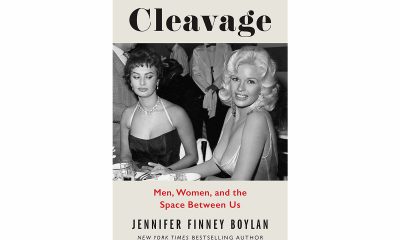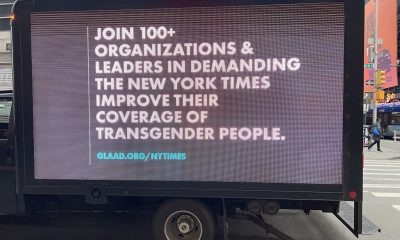Books
Trans memoirist measures time through dogs she’s owned
‘Good Boy’ is clever perspective on life by Jennifer Finney Boylan
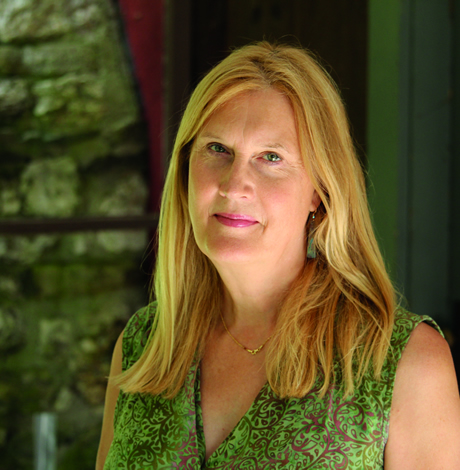
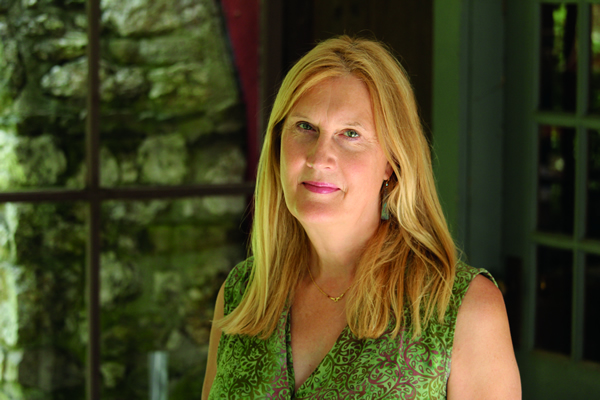
‘Good Boy: My Life in Seven Dogs’
By Jennifer Finney Boylan
Celadon Books
$26.99
288 pages
If you’re allergic to love or if the smell of a playful puppy sets your teeth on edge, stay clear of this book.
Though infused with wry wit and astute cultural observations, “Good Boy: My Life in Seven Dogs,” the latest memoir by trans activist and writer Jennifer Finney Boylan, is jam-packed with the warmth of human and canine connections.
Proust had his “little madeleines.” Boylan, 61, recalls key moments in the life of herself and her family through the seven dogs she’s had in her lifetime.
Boylan, who was on the GLAAD board of directors from 2011-2018, is one of the most elegant writers you’d ever hope to read. She’s already written three memoirs. Her 2003 memoir “She’s Not There: A Life in Two Genders” was the first bestselling work by a transgender American. You’d think that writing “Good Boy,” a fourth memoir, would be overkill. And in lesser hands, it would be gilding the lily. But, this isn’t the case with Boylan, who’s a brilliant stylist and memoirist.
“My days have been numbered in dogs,” Boylan writes. “Even now, when I try to take the measure of the people I have been, I count the years by the dogs I owned in each season.”
Boylan, a Valley Forge, Pa., native, was assigned male at birth. She was named James, aka Jimmy. Boylan uses the pronoun “he” to refer to herself in youth. Jimmy wasn’t your typical boy. He was an “adorable nerd who’d spent his days sitting on the banks of a stream in Pennsylvania, fishing for brook trout,” Boylan recalls. He secretly played with his mother’s curlers. Jimmy went to college and graduate school (at Wesleyan University and Johns Hopkins University respectively) and fell in love with and married Deedie. They had two children.
In 2000, Boylan came out as a transwoman named Jennifer. Boylan and Deedie have now lived together longer as wife and wife longer than they lived as husband and wife.
Boylan’s never regretted coming out as trans or giving up the shame and secrecy of being closeted.
“But there were times when I remembered my younger self the way you’d remember a dear friend you’d lost,” she writes, “for reasons you no longer quite understood.”
“I wondered sometimes, what had become of him,” she writes. “Would it be necessary, in the days to come, to refer to him only in scare quotes?”
Musing on the dogs in her life helps Boylan to connect with this former version of herself. In the midst of the pandemic, nothing could be more fortunate for readers. I don’t mean to make light of the hard times Boylan and her family have lived through: from her coming out as trans at a time when few people even knew what being transgender meant to her father’s illness and death. Yet, the Boylan family dogs are some of the, by turns, funniest, most bad-ass, poignant creatures you’d ever want to meet.
When Boylan was a young boy, her family had a dalmatian named Playboy. He was, “a resentful hoodlum who loved no one except my father,” Boylan writes.
Matt, a mutt with an insatiable sex drive, was the family pooch when Boylan was at Wesleyan. Matt’s “disregard for the rule of law made it abundantly clear that he was determined, as they say in Ireland, to live a life given over totally to pleasure,” Boylan writes.
Lucy, a retriever/chow chow mash-up, was the dog who saw Boylan as she was first coming out as trans. She “was on duty the day I finally came down the stairs in heels,” Boylan recalls. “Ugh, she said, I wish the Lord would take me now.”
A lot of people, including the people she loved most, had the same reaction at first, Boylan remembers.
Though “Good Boy,” is structured around dogs, the people in Boylan’s life are equally important to her story. Her tale has some unexpected twists — from her elderly mother’s acceptance when she comes out as trans to a surprising revelation from one of her children.
If you’re looking for wry wit and hope in the midst of the pandemic, check our “Good Boy.”
Books
Embracing the chaos can be part of the fun
‘Make Sure You Die Screaming’ offers many twists and turns
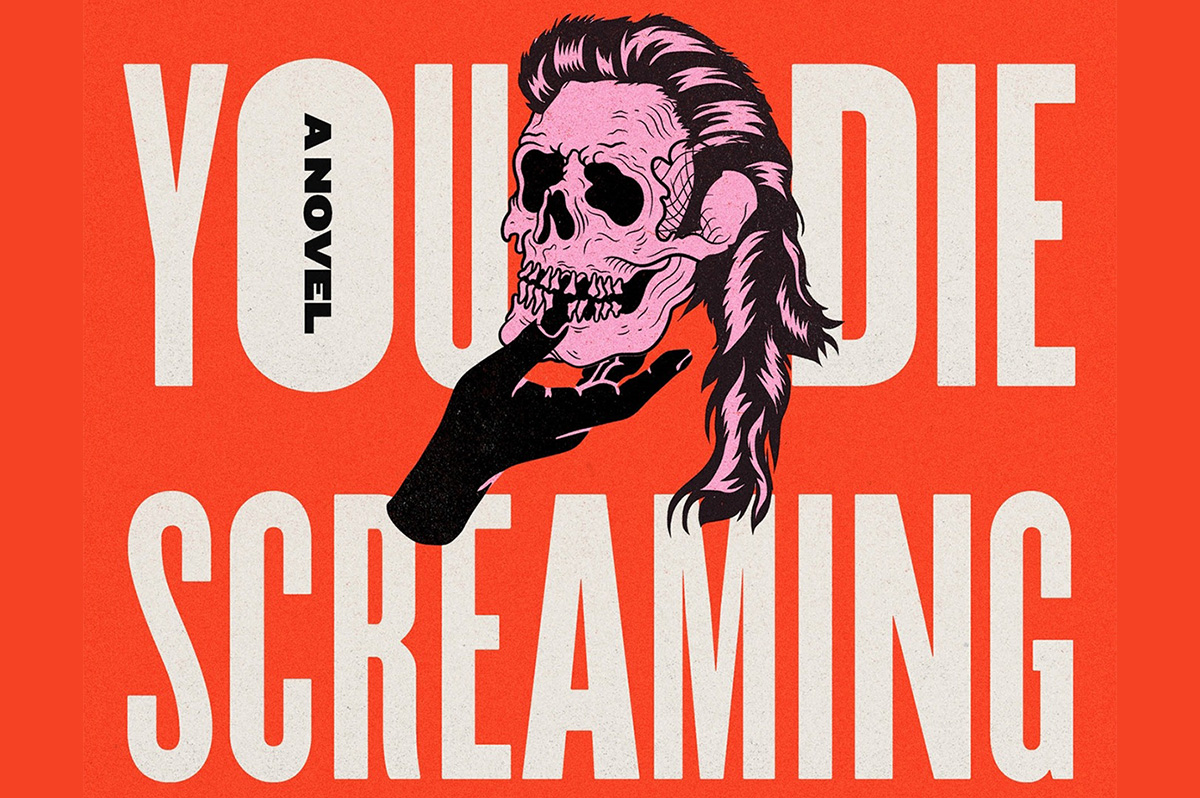
‘Make Sure You Die Screaming’
By Zee Carlstrom
c.2025, Random House
$28/304 pages
Sometimes, you just want to shut the door and forget what’s on the other side.
You could just wipe it from your memory, like it didn’t occur. Or create an alternate universe where bad things never happen to you and where, as in the new novel “Make Sure You Die Screaming” by Zee Carlstrom, you can pretend not to care.

Their mother called them “Holden,” but they’d stopped using that name and they hadn’t decided what to use now. What do you call an alcoholic, queer, pessimistic former ad executive who’s also “The World’s First Honest White Man,” although they no longer identify as a man? It’s a conundrum that they’ll have to figure out soon because a cop’s been following them almost since they left Chicago with Yivi, their psychic new best friend.
Until yesterday, they’d been sleeping on a futon in some lady’s basement, drinking whatever Yivi mixed, and trying not to think about Jenny. They killed Jenny, they’re sure of it. And that’s one reason why it’s prudent to freak out about the cop.
The other reason is that the car they’re driving was stolen from their ex-boyfriend who probably doesn’t know it’s gone yet.
This road trip wasn’t exactly well-planned. Their mother called, saying they were needed in Arkansas to find their father, who’d gone missing so, against their better judgment, they packed as much alcohol as Yivi could find and headed south. Their dad had always been unique, a cruel man, abusive, intractable; he suffered from PTSD, and probably another half-dozen acronyms, the doctors were never sure. They didn’t want to find him, but their mother called…
It was probably for the best; Yivi claimed that a drug dealer was chasing her, and leaving Chicago seemed like a good thing.
They wanted a drink more than anything. Except maybe not more than they wanted to escape thoughts of their old life, of Jenny and her death. And the more miles that passed, the closer they came to the end of the road.
If you think there’s a real possibility that “Make Sure You Die Screaming” might run off the rails a time or three, you’re right. It’s really out there, but not always in a bad way. Reading it, in fact, is like squatting down in a wet, stinky alley just after the trash collector has come: it’s filthy, dank, and profanity-filled. Then again, it’s also absurd and dark and philosophical, highly enjoyable but also satisfying and a little disturbing; Palahniuk-like but less metaphoric.
That’s a stew that works and author Zee Carlstrom stirs it well, with characters who are sardonic and witty while fighting the feeling that they’re unredeemable losers – which they’re not, and that becomes obvious.
You’ll see that all the way to one of the weirdest endings ever.
Readers who can withstand this book’s utter confusion by remembering that chaos is half the point will enjoy taking the road trip inside “Make Sure You Die Screaming.”
Just buckle up tight. Then shut the door, and read.
The Blade may receive commissions from qualifying purchases made via this post.
Books
Two new books on dining out LGBTQ-style
Visit nightclubs, hamburger joints, and a bathhouse that feeds customers

‘What is Queer Food? How We Served a Revolution’
By John Birdsall
c.2025, W.W. Norton
$29.99/304 pages
‘Dining Out: First Dates, Defiant Nights, and Last Call Disco Fries at America’s Gay Restaurants’
By Erik Piepenburg
c.2025, Grand Central
$30/352 pages
You thought a long time about who sits where.
Compatibility is key for a good dinner party, so place cards were the first consideration; you have at least one left-hander on your guest list, and you figured his comfort into your seating chart. You want the conversation to flow, which is music to your ears. And you did a good job but, as you’ll see with these two great books on dining LGBTQ-style, it’s sometimes not who sits where, but whose recipes were used.
When you first pick up “What is Queer Food?” by John Birdsall, you might miss the subtitle: “How We Served a Revolution.” It’s that second part that’s important.

Starting with a basic gay and lesbian history of America, Birdsall shows how influential and (in)famous 20th century queer folk set aside the cruelty and discrimination they received, in order to live their lives. They couldn’t speak about those things, he says, but they “sat down together” and they ate.
That suggested “a queer common purpose,” says Birdsall. “This is how who we are, dahling, This is how we feed our own. This is how we stay alive.”
Readers who love to cook, bake or entertain, collect cookbooks, or use a fork will want this book. Its stories are nicely served, they’re addicting, and they may send you in search of cookbooks you didn’t know existed.
Sometimes, though, you don’t want to be stuck in the kitchen, you want someone else to bring the grub. “Dining Out” by Erik Piepenburg is an often-nostalgic, lively look at LGBTQ-friendly places to grab a meal – both now and in the past.

In his introduction, Piepenburg admits that he’s a journalist, “not a historian or an academic,” which colors this book, but not negatively. Indeed, his journeys to “gay restaurants” – even his generous and wide-ranging definitions of the term – happily influence how he presents his narrative about eateries and other establishments that have fed protesters, nourished budding romances, and offered audacious inclusion.
Here, there are modern tales of drag lunches and lesbian-friendly automats that offered “cheap food” nearly a century ago. You’ll visit nightclubs, hamburger joints, and a bathhouse that feeds customers on holidays. Stepping back, you’ll read about AIDS activism at gay-friendly establishments, and mostly gay neighborhood watering holes. Go underground at a basement bar; keep tripping and meet proprietors, managers, customers and performers. Then take a peek into the future, as Piepenburg sees it.
The locales profiled in “Dining Out” may surprise you because of where they can be found; some of the hot-spots practically beg for a road trip.
After reading this book, you’ll feel welcome at any of them.
If these books don’t shed enough light on queer food, then head to your favorite bookstore or library and ask for help finding more. The booksellers and librarians there will put cookbooks and history books directly in your hands, and they’ll help you find more on the history and culture of the food you eat. Grab them and you’ll agree, they’re pretty tasty reads.
The Blade may receive commissions from qualifying purchases made via this post.

You’re going to be on your feet a lot this month.
Marching in parades, dancing in the streets, standing up for people in your community. But you’re also likely to have some time to rest and reflect – and with these great new books, to read.
First, dip into a biography with “Marsha: The Joy and Defiance of Marsha P. Johnson” by Tourmaline (Tiny Rep Books, $30), a nice look at an icon who, rumor has it, threw the brick that started a revolution. It’s a lively tale about Marsha P. Johnson, her life, her activism before Stonewall and afterward. Reading this interesting and highly researched history is a great way to spend some time during Pride month.
For the reader who can’t live without music, try “The Dad Rock That Made Me a Woman” by Niko Stratis (University of Texas Press, $27.95), the story of being trans, searching for your place in the world, and finding it in a certain comfortable genre of music. Also look for “The Lonely Veteran’s Guide to Companionship” by Bronson Lemer (University of Wisconsin Press, $19.95), a collection of essays that make up a memoir of this and that, of being queer, basic training, teaching overseas, influential books, and life.
If you still have room for one more memoir, try “Walk Like a Girl” by Prabal Gurung (Viking, $32.00). It’s the story of one queer boy’s childhood in India and Nepal, and the intolerance he experienced as a child, which caused him to dream of New York and the life he imagined there. As you can imagine, dreams and reality collided but nonetheless, Gurung stayed, persevered, and eventually became an award-winning fashion designer, highly sought by fashion icons and lovers of haute couture. This is an inspiring tale that you shouldn’t miss.
No Pride celebration is complete without a history book or two.
In “Trans History: From Ancient Times to the Present Day” by Alex L. Combs & Andrew Eakett ($24.99, Candlewick Press), you’ll see that being trans is something that’s as old as humanity. One nice part about this book: it’s in graphic novel form, so it’s lighter to read but still informative. Lastly, try “So Many Stars: An Oral History of Trans, Nonbinary, Genderqueer, and Two-Spirit People of Color” by Caro De Robertis (Algonquin Books of Chapel Hill. $32.00) a collection of thoughts, observations, and truths from over a dozen people who share their stories. As an “oral history,” you’ll be glad to know that each page is full of mini-segments you can dip into anywhere, read from cover to cover, double-back and read again. It’s that kind of book.
And if these six books aren’t enough, if they don’t quite fit what you crave now, be sure to ask your favorite bookseller or librarian for help. There are literally tens of thousands of books that are perfect for Pride month and beyond. They’ll be able to determine what you’re looking for, and they’ll put it directly in your hands. So stand up. March. And then sit and read.
-

 Federal Government1 day ago
Federal Government1 day agoTreasury Department has a gay secretary but LGBTQ staff are under siege
-

 Virginia2 days ago
Virginia2 days agoDefying trends, new LGBTQ center opens in rural Winchester, Va.
-

 Opinions3 days ago
Opinions3 days agoUSAID’s demise: America’s global betrayal of trust with LGBTQ people
-
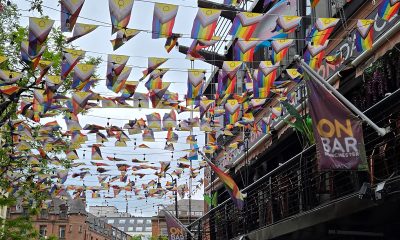
 Travel4 days ago
Travel4 days agoManchester is vibrant tapestry of culture, history, and Pride

